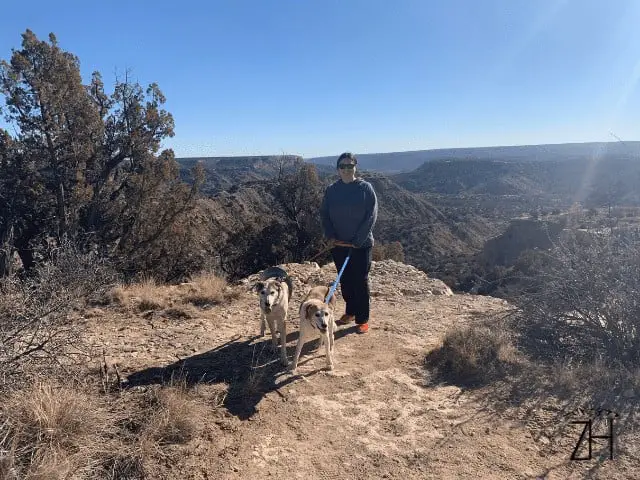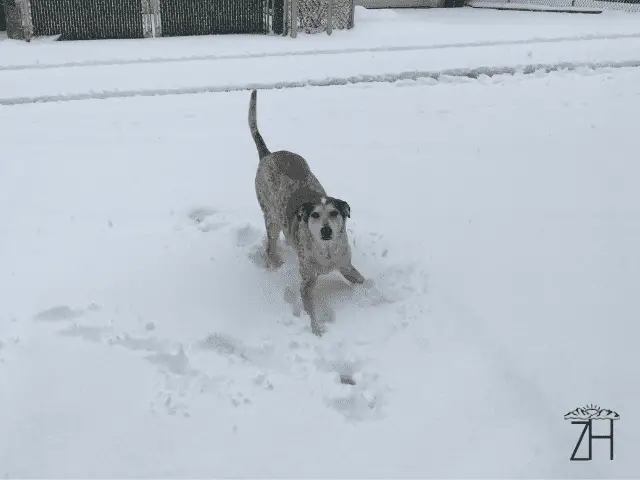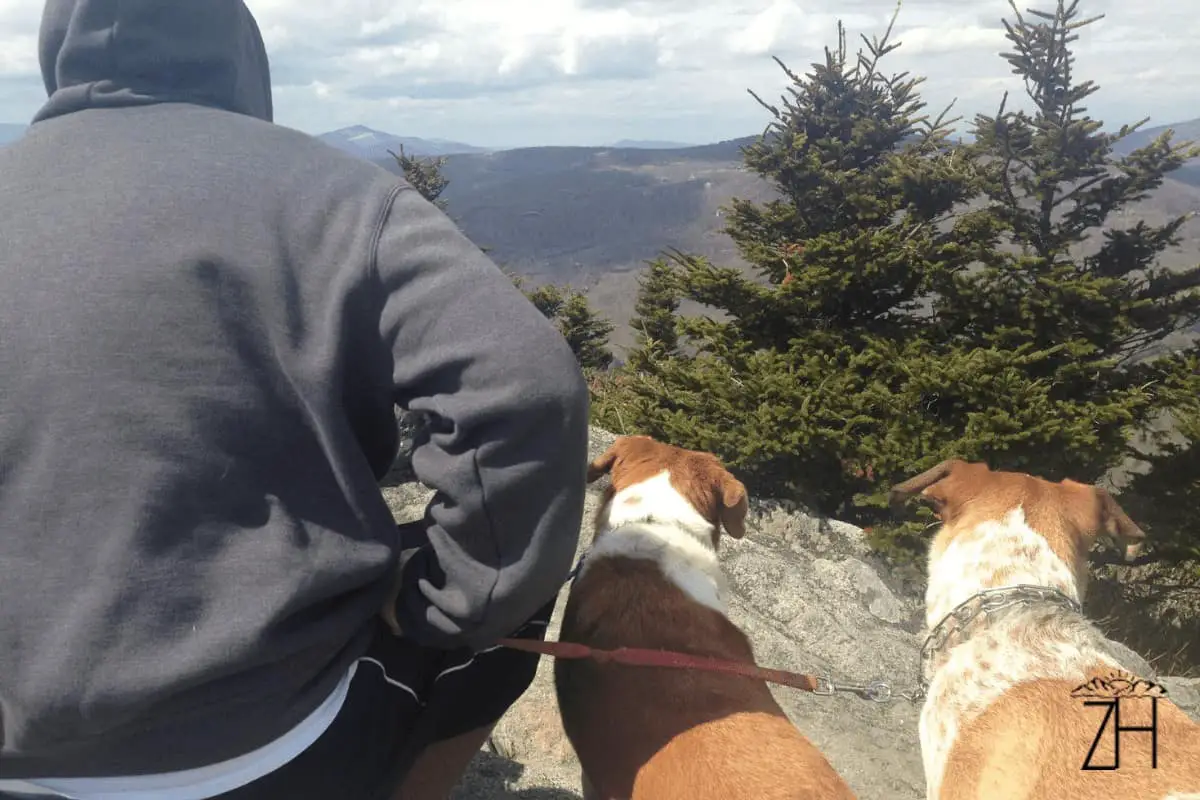As man’s best friend, we always want to take our dogs along to the coolest adventures. However, when it comes to the literal meaning of “cool”, some people might be reluctant about taking their dogs on a stroll in winter, which leads many to ask “can my dog hike in the cold?”
In today’s article, we’ll walk you through a brief guide with answers to this question as well as valuable tips to keep in mind to ensure your dog’s safety in the cold. So without further ado, let’s jump right in!
This article may contain affiliate links. If you purchase through one of these links we may earn a commission. This money helps us continue to make free content for you! Thank you for your support!
Is It Safe for a Dog to Hike in Cold Weather?
The answer to this question varies greatly depending on a wide range of factors and aspects that you have to keep in mind.
However, as a rule of thumb, it’s recommended that you always be more careful and vigilant when you take your dog on a hike in such cold weather, even if your dog’s breed is built to endure the harsh cold of winter.
Factors That Affect the Safety of Your Dog in Cold Weather Hikes

Now that you’re aware that there are several factors that can affect your dog’s ability to withstand a hike in the cold, let’s have a quick look at each one of them. This way, you’ll be able to assess whether your dog is capable of hiking in the cold.
And after reading these you’re still not sure how your dog’s breed, age, etc will fair in cold weather, be sure to ask your vet!
Breed
The breed of the dog is one of the major aspects that have a primary impact on its ability to withstand the cold.
A dog breed with a thicker fur coat will be more likely to endure the harsh cold. This includes breeds like Alaskan Malamute, Siberian Husky, Bernese Mountain Dog, Great Pyrenees, Saint Bernard, and long-haired German Shepherds, etc.
On the other hand, breeds with smaller builds and thin hair coats aren’t naturally built to tolerate the cold, so they can only be exposed to cold temperatures that are above freezing points to avoid any sickness or severe exhaustion.
I would also highly recommend getting your short haired dog a cold weather jacket if you’re going to be hiking for an extended time in cold weather.
Even if you think it looks funny to see dogs wearing jackets, short haired breeds need that extra protection in cold weather. A good cold weather jacket will also help protect your dog from getting wet from the rain and/or snow which is a key component for staying warm.
This includes breeds like bulldogs, boxers, chihuahua, small terriers, Doberman, and greyhounds.
Age

Even if the dog’s breed is fit to withstand the cold, puppies shouldn’t be allowed to walk in cold weather. This is simply because dogs’ immunity to the cold is weaker and their ability to regulate their body temperature is poorer when they’re so young.
A puppy be allowed out in cold or snowy conditions to go to the bathroom only, at least for the first 6 months of its life.
You also need to be especially cautious with senior dogs as well. Senior dogs can also have the similar issues with their immune system and ability to regulate body temperature as puppies do, so they exposure to the cold should be limited.
Our dogs, Chompers and Mia are 16 and 11. Once the temperature gets down around freezing (32 degrees), we’ll limit our hikes to about 30 minutes. If it gets colder than that, we put on a hold on our hikes with them until it gets a bit warmer.
Physical Fitness and Training
If you live in an area where it doesn’t get too cold in winter or your dog is always inside and never exposed to the outside when it’s cold, your dog may not be physically fit to tolerate the cold, even if they belong to a breed that should handle it.
In that case, you’ll need to gradually expose your dog to the cold for an increasing period of time until they’re capable of hiking out in such weather.
Additionally, your dog should be properly trained to obey your orders and walk properly on a leash because uncooperative dogs in the cold will put both of you in danger if emergency calls for a shelter.
Health State
Hiking involves walking for long distances with a few breaks every now and then, and there are several health conditions that prevent a dog from putting up with such a heavy activity, especially when it’s extremely cold outside.
For example, hiking is not recommended for dogs with any kind of heart condition because it can put a lot of stress on their cardiac muscle, let alone the extra pressure of pumping to warm up the body.
Additionally, dogs with joint problems, such as recent traumas, arthritis, etc should avoid hiking altogether to avoid the excessive stress on the joints.
How Long Can Your Dog Hike in Winter?

One thing you need to know is that even dogs that are built to endure the cold may not be capable of hiking for a long distance when the temperature is well below the freezing point, especially if your dog isn’t used to these conditions.
As a rule of thumb, if your dog has a relatively thick fur coat and is capable of enduring the cold, it’s better to start with a short hike to get your dog used to the situation.
For instance, you can start with a short 10 to 15 minute hike and work your way up to double that time when your dog is ready, all while taking the other factors mentioned above in mind.
If the temperature is cold but not below the freezing point, your dog should be able to hike for longer, which ranges between 30 to 60 minutes depending on the temperature and the speed of the wind.
Even on longer hikes, it’s always best to check on your dog and make sure that he or she is okay. It’s also recommended that you always take a short break to allow your dog to warm up and take a breather if they’re exhausted.
What Are the Signs That My Dog is Too Cold?
If your dog is acting naturally in the cold, it’s a good sign that they’re able to tolerate the cold. Of course, some minor shivering is okay because it’s a natural reaction to keep their bodies warm.
However, if you noticed excessive shaking or any of the following signs, you should stop the hike immediately to try to warm up your dog and protect them from hypothermia:
- Hunching and tucking their tails between the hind legs
- Runny nose with coughing or sneezing
- Lift paws continuously off the ground
- Whining and/or barking
- Resisting to walking and trying to turn around
- Weakness or lethargy
- Changes in behavior
Essential Safety Tips While Taking Your Dog out on a Hike

Here are some additional tips to help you keep your furry friend safe while hiking together in the cold:
- Always Put the Dog on a Leash
Never allow your dog to roam freely in the cold because getting lost in such weather can be extremely dangerous to them, even if they’re built to endure the cold.
Even after finding the dogs through GPS microchips, your dog might be extremely sick from the cold.
- Warm Up Your Dog’s Paws and Torso
If your dog has relatively short hair, you can still take it on a hike even on cold days. However, you need to properly warm them up with dog sweaters and jackets. These clothes use heavy fabrics to make up for the lack of fur in these dogs.
While dog boots and socks might seem funny in regular situations, they can save your dog’s life in such cold weather.
- Don’t Forget About Hydration
Even if your dog is handling the snow pretty well, it’s not a good source of hydration because snow is mostly air and depletes your dog’s warmth reserves.
For that reason, always make sure that you pack extra water for you and your dog and never rely on streams on the way because they might be frozen when you reach them.
- Feed Your Dog a Calorie Rich Diet Before Going on the Hike
Calorie rich food helps your dog maintain the internal warmth necessary to power through the cold.
It’s also essential that you pack extra snacks for your doggie because cold weather will make them hungrier.
Final Thoughts
With that said, you now have a complete answer with all the essential safety tips to answer the popular question “can my dog hike in the cold?”.
As you can see, the dog’s breed, age, and health condition have a huge impact on the maximum amount of time to take your dog on a hike in winter.
Remember to always follow the tips mentioned above to ensure your dog’s safety and stop the hike immediately if you suspect that your dog is having a hard time tolerating the weather.


